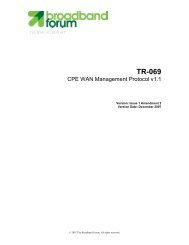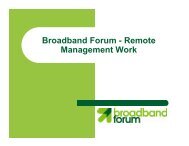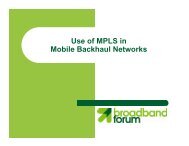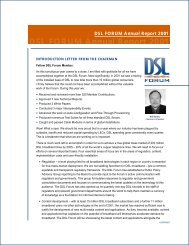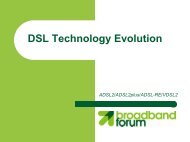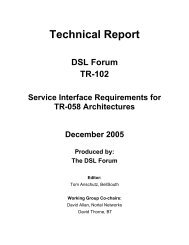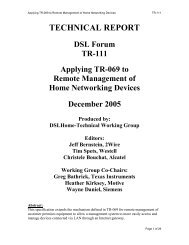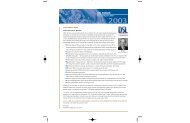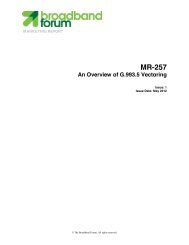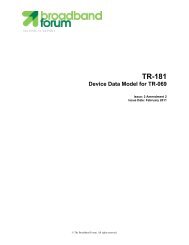MPLS in Mobile Backhaul Networks Framework and Requirements ...
MPLS in Mobile Backhaul Networks Framework and Requirements ...
MPLS in Mobile Backhaul Networks Framework and Requirements ...
Create successful ePaper yourself
Turn your PDF publications into a flip-book with our unique Google optimized e-Paper software.
<strong>MPLS</strong> <strong>in</strong> <strong>Mobile</strong> <strong>Backhaul</strong> <strong>Networks</strong> <strong>Framework</strong> <strong>and</strong> <strong>Requirements</strong> Technical Specification IP/<strong>MPLS</strong> Forum 20.0.0<br />
___________________________________________________________________________________<br />
used for UMTS R5, R6, R7, CDMA 2000, 3GPP2 networks. Figure 3 presents different TNL scenarios<br />
us<strong>in</strong>g <strong>MPLS</strong> technology <strong>in</strong> Access/Aggregation networks to transport all these k<strong>in</strong>d of TNL. A detailed<br />
list<strong>in</strong>g is provided <strong>in</strong> Table 1.<br />
Table 1: Different RANs of Centralized <strong>Mobile</strong> <strong>Networks</strong> with Correspond<strong>in</strong>g TNL<br />
Network Specification TNL<br />
GSM/GPRS/EDGE<br />
(2G/2.5G)<br />
TDM<br />
UMTS<br />
R3, R99/R4 ATM<br />
R99/R5, R6, R7<br />
ATM<br />
IP<br />
CDMA 1x-RTT IS-2000 HDLC or TDM<br />
CDMA 1x EV-DO IS-856 IP<br />
In the context of this work, the scenarios aris<strong>in</strong>g out of these TNLs are hereafter referred to as TNL<br />
Scenarios s<strong>in</strong>ce they refer to the transport service provided by the <strong>MPLS</strong> network to the mobile network.<br />
Thus we have the follow<strong>in</strong>g TNL scenarios:<br />
1. TDM TNL<br />
2. ATM TNL<br />
3. IP TNL<br />
4. HDLC TNL<br />
For each supported TNL scenario, the <strong>MPLS</strong> transport network may extend from the RNC to various<br />
nodes <strong>in</strong> the mobile Access/Aggregation network, as <strong>in</strong>dicated by cases (a) through (f). These are referred<br />
to as <strong>MPLS</strong> use cases.<br />
Note: It should be noted that the TNLs associated with the RAN technologies above are the typical case<br />
but do not constitute absolute requirements. E.g., 2G/GSM RAN equipment can be retrofitted to work<br />
over an IP TNL.<br />
5.1 TNL Scenarios for <strong>MPLS</strong> <strong>in</strong> centralized mobile networks<br />
As mentioned above, four TNL scenarios are identified for <strong>MPLS</strong> <strong>in</strong> centralized mobile networks based<br />
upon the <strong>in</strong>terface or Transport Network Layers used between BS (BTS or NodeB) <strong>and</strong> Controllers (BSC<br />
or RNC).<br />
The <strong>in</strong>terwork<strong>in</strong>g function (IWF) necessary to transport traffic of the emulated service over <strong>MPLS</strong> is<br />
performed <strong>in</strong> the edge node, or <strong>in</strong> the access node, or at the CSG or MASG at the edge of the <strong>MPLS</strong><br />
network. These nodes perform the <strong>MPLS</strong> PE function.<br />
Case 1 – TDM TNL<br />
Case 1 refers to a TDM layer featured <strong>in</strong> the 2G TNL: it covers base stations communicat<strong>in</strong>g by means of<br />
TDM bit streams (T1/E1/T3/E3/OC-3c/STM-1c). This case covers RAN equipment connected with a<br />
T1/E1 <strong>in</strong>terface.<br />
October 2008 Page 16



